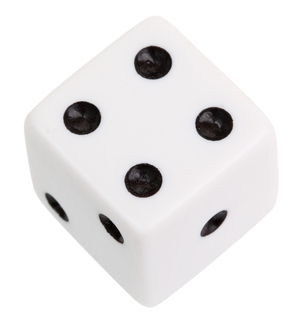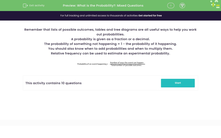What do you remember about probability?

In this activity, we will look at a mix of probability questions - similar to ones you have seen in the past!
Here is a recap of what we've learnt about probability:
Probability is calculated by dividing the number of desired outcomes (what we are finding the probability of) by the number of all possible outcomes.
For example, the probability of getting heads on a fair coin is P(H) = 1/2 because there is 1 side with heads on it out of 2 possible sides it can land on!
We can write probability as a fraction, decimal or percentage.
So, the our probability of getting heads is P(H) = 1/2 = 0.5 = 50%
Unless the question specifies what form the answer should be, you can choose whichever one you are most comfortable with!

The probability of something not happening is 1 minus the the probability of it happening.
For example, the probability of getting a 5 on a fair die is 1/6.
So the probability of not getting a 5 is: 1 - 1/6 = 5/6

Finally, any time we want to calculate the probability of event A or event B happening, we add their respective probabilities:
P(A or B) = P(A) + P(B)
For example, the probability of throwing a 2 or a 5 on a six-sided die is:
P(getting a 2 or a 5) = P(getting a 2) + P(getting a 5) = 1/6 + 1/6 = 2/6
Similarly, any time we want to calculate the probability of event A and event B happening, we multiply their respective probabilities:
P(A and B) = P(A) x P(B)
For example, the probability of getting a heads on a coin and a 4 on a six-sided die is:
P(getting heads and a 4) = P(heads) x P(getting a 4) = 1/2 × 1/6 = 1/12
Phew - there's a lot to remember there! You can look back at this introduction at any point by clicking on the red help button on the screen.

Let's have a go at some questions!








